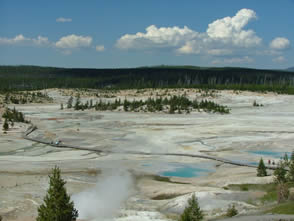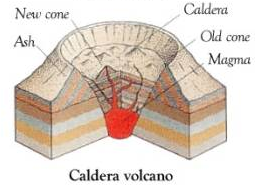Supervolcano Caldera
Volcano Learning Zone > Types of volcano > Supervolcano Caldera
Supervolcano eruptions are the largest form of volcanic eruption, and result in vast volumes of volcanic material being erupted into the atmosphere. Yellowstone is a supervolcano which last erupted 600,000 years ago. A supervolcano usually forms over a hot spot or mantle plume and under continental crust. They often appear on the surface as a large depression called a caldera which can be 10 s of km across. The depression is sometimes filled with a lake as at Taupo in New Zealand. The caldera is formed as the magma inside is violently blown out of the magma chamber below. Initially this is from the edges then the whole caldera floor collapses, leaving a flat bottomed depression surrounded by steep sides.
 Eruptions are incredibly violent and dramatic and although volcanologists and TV crews would love to see one, the rest of the world can wait!! Yellowstone has been much talked about in the media as due for an eruption but there are no signs of this just yet. Hooray!
Eruptions are incredibly violent and dramatic and although volcanologists and TV crews would love to see one, the rest of the world can wait!! Yellowstone has been much talked about in the media as due for an eruption but there are no signs of this just yet. Hooray!
A supervolcano has not erupted within the modern technological age. The most recent eruption that gets close is the 1815 eruption of Tambora in Indonesia wich ejcted 100 km3 of material. Previous to this the last true supervolcano eruption was Taupo New Zealand 26 000 years ago whcih ejected 800km3 of material. Both these eruptions dramativally effected the worlds climate and food availability.


